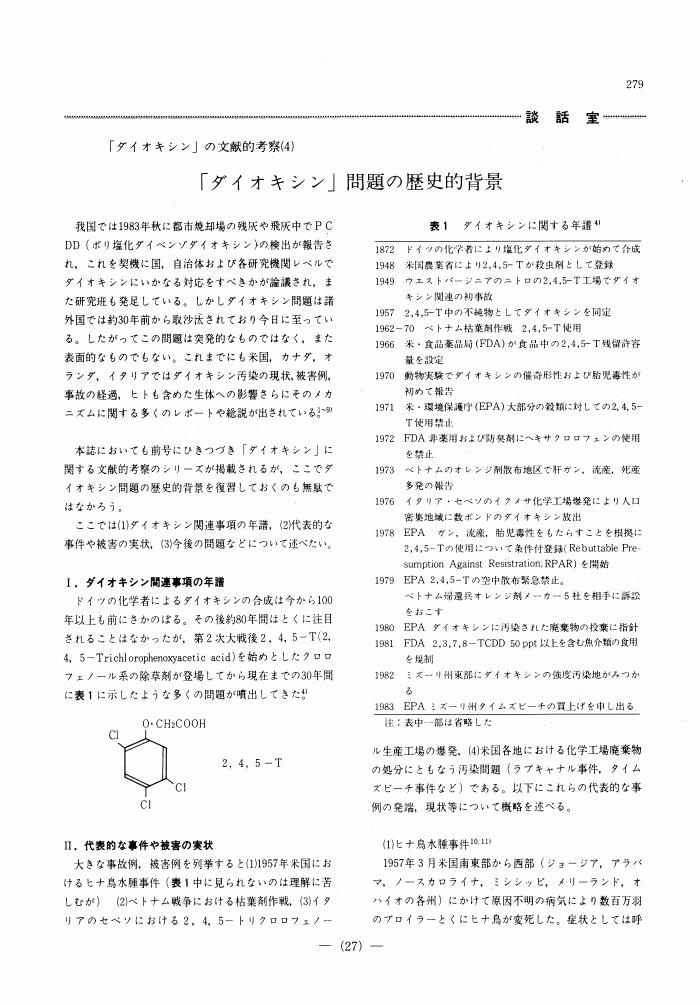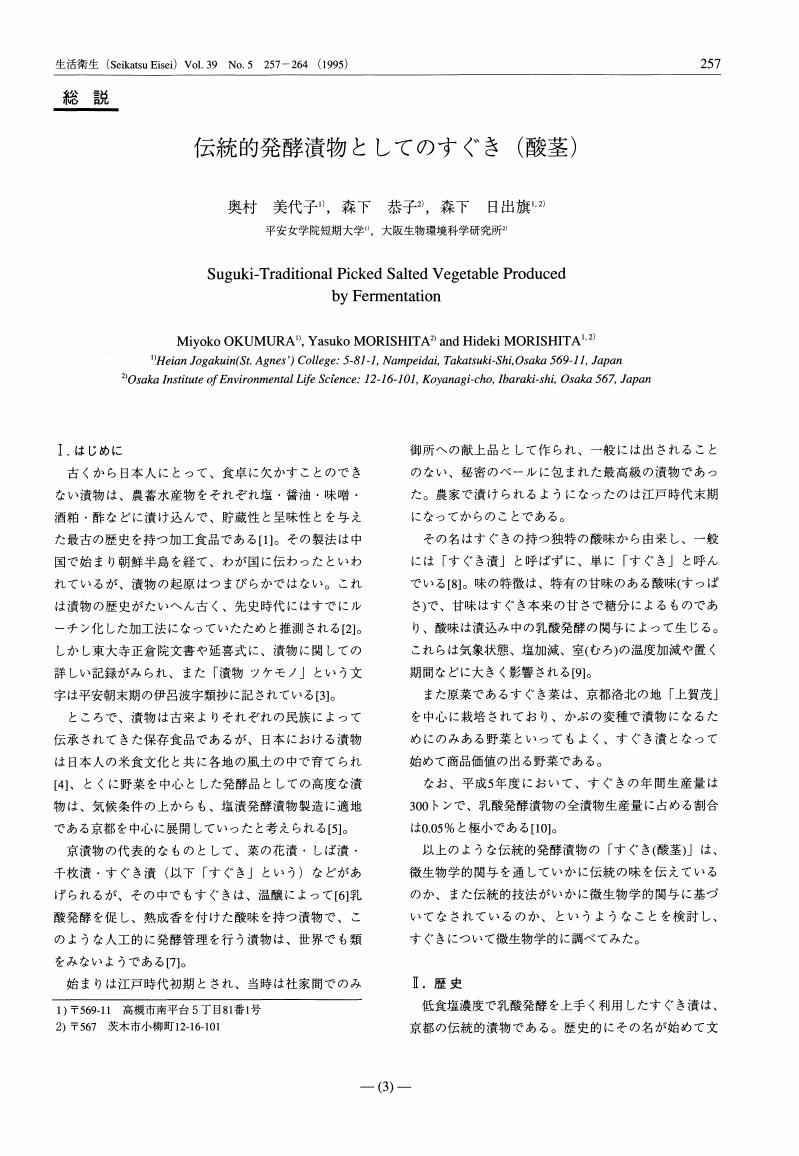4 0 0 0 OA 窒素酸化物による大気汚染と生体影響
- 著者
- 中島 泰知 楠本 繁子 織田 肇
- 出版者
- 社団法人 大阪生活衛生協会
- 雑誌
- 生活衛生 (ISSN:05824176)
- 巻号頁・発行日
- vol.17, no.2, pp.32-43, 1973-04-20 (Released:2010-03-11)
- 参考文献数
- 46
4 0 0 0 OA 食物繊維の構造と機能
- 著者
- 中山 行穂
- 出版者
- 社団法人 大阪生活衛生協会
- 雑誌
- 生活衛生 (ISSN:05824176)
- 巻号頁・発行日
- vol.35, no.1, pp.32-37, 1991-01-10 (Released:2010-03-11)
- 参考文献数
- 7
4 0 0 0 OA 食品中のニコチン酸による急性中毒
- 著者
- 山田 明男
- 出版者
- 社団法人 大阪生活衛生協会
- 雑誌
- 生活衛生 (ISSN:05824176)
- 巻号頁・発行日
- vol.30, no.2, pp.107-109, 1986-03-10 (Released:2010-03-11)
- 参考文献数
- 10
4 0 0 0 OA 洗濯によるカビ汚染の除去
- 著者
- 濱田 信夫 藤田 忠雄 中村 正樹
- 出版者
- Osaka Urban Living and Health Association
- 雑誌
- 生活衛生 (ISSN:05824176)
- 巻号頁・発行日
- vol.46, no.3, pp.85-90, 2002-05-30 (Released:2010-03-11)
- 参考文献数
- 9
- 被引用文献数
- 2
The sterilizing effects of laundry detergent and oxygen and chlorine bleach on fungal spores were examined. Bleach did not appreciably kill spores of common fungi such as Penicillium and Cladosporium species in water at 25°C, but, increase in water temperature accelerated the sterilizing effect of bleach. Hot water, higher than 30°C, with bleach was effective for killing fungal spores.Bleach is more effective than detergent for washing cloth samples contaminated with the species of Cladosporium used in 25°C water, although fungal spores are not effectively killed. Fungal mycelia are more sensitive to bleach than their spores, so mycelia on fabric are bleached more easily than their spores.
4 0 0 0 OA 茶殻を用いた消臭の効果について
- 著者
- 増田 淳二 森脇 洋 福山 丈二
- 出版者
- Osaka Urban Living and Health Association
- 雑誌
- 生活衛生 (ISSN:05824176)
- 巻号頁・発行日
- vol.48, no.2, pp.92-96, 2004 (Released:2005-01-27)
- 参考文献数
- 5
- 被引用文献数
- 1
The deodorizing effects of tea leaves and used tea leaves were evaluated. Absorption capacities of sencha (Japanese green tea), hojicha (Japanese roasted tea), oolong tea and black tea for hydrogen sulfide, methyl mercaptan, toluene and ammonia were determined. These tea leaves were found to absorb small amounts of toluene and negligible amounts hydrogen sulfide and methyl mercaptan, but were very effective in absorbing. No correlation was found between the catechin concentrations of the tea leaves and their absorption capacities.
4 0 0 0 OA ガーゼ繊維による粒子状物質捕集の衛生学的効果
- 著者
- 芳住 邦雄
- 出版者
- Osaka Urban Living and Health Association
- 雑誌
- 生活衛生 (ISSN:05824176)
- 巻号頁・発行日
- vol.32, no.4, pp.182-186, 1988-07-10 (Released:2010-03-11)
- 参考文献数
- 11
The filtration of respirable particles by an absorbent gauze, one of the most popular mask materials, was examined from the standpoint of its hygienic validity. The ambient particulate matter with a diameter of less than 2.1μm was collected by rearranging the Andersen sampler stages. It was found that the collection efficiency of 10 layers of absorbent gauge was only 15% with respect to those res pirable particles. It is concluded that the effectiveness of an absorbent gauge mask is not sufficient because 85% of respirable particles in the ambient air will brake through it.
4 0 0 0 OA 食事脂肪と血清脂質
- 著者
- 亀井 正治
- 出版者
- 社団法人 大阪生活衛生協会
- 雑誌
- 生活衛生 (ISSN:05824176)
- 巻号頁・発行日
- vol.37, no.5, pp.197-213, 1993-09-10 (Released:2010-03-11)
- 参考文献数
- 60
- 被引用文献数
- 1
4 0 0 0 OA 日本人はウエストナイルウイルス交差免疫を持つか
- 著者
- 今井 長兵衛
- 出版者
- (社)大阪生活衛生協会
- 雑誌
- 生活衛生 (ISSN:05824176)
- 巻号頁・発行日
- vol.51, no.4, pp.225-240, 2007 (Released:2007-08-07)
- 参考文献数
- 38
West Nile virus (WNV), St. Louis Encephalitis virus (SLEV) and Japanese Encephalitis virus (JEV) are closely related and all belong to the JEV antigen group of flaviviruses. An epidemic of WNV was first reported from the United States in 1999, where an SLEV epidemic had been observed since 1933 in central and southern regions. Recently, the probability of the spread of WNV to Japan has increased year by year. The present article first described the relationship between the WNV and SLEV epidemics in the United States in order to suggest the existence of a cross-immunity to WNV caused by SLEV infection in the American population. Secondly, the past and present status of JEV epidemics and JEV vaccination in Japan were explained in relation to the socio-economic changes after the Second World War. Finally, the article suggested that the level of cross-immunity to WNV caused by natural infection and vaccination with JEV in the Japanese population may not be high enough to prevent a WNV epidemic after the possible future spread of WNV to Japan.
3 0 0 0 OA 静電気の血液像および血清電解質に及ぼす影響
- 著者
- 谷口 繁 森田 茂 山田 明男
- 出版者
- 社団法人 大阪生活衛生協会
- 雑誌
- 生活衛生 (ISSN:05824176)
- 巻号頁・発行日
- vol.13, no.5, pp.129-132, 1969-10-20 (Released:2010-03-11)
- 参考文献数
- 10
3 0 0 0 OA 「ダイオキシン」の文献的考察 (4)「ダイオキシン」問題の歴史的背景
- 著者
- 川合 真一郎
- 出版者
- 社団法人 大阪生活衛生協会
- 雑誌
- 生活衛生 (ISSN:05824176)
- 巻号頁・発行日
- vol.28, no.5, pp.279-284, 1984-09-10 (Released:2010-03-11)
- 参考文献数
- 28
3 0 0 0 OA 酸素欠乏事故について
- 著者
- 冨田 絹子
- 出版者
- 社団法人 大阪生活衛生協会
- 雑誌
- 生活衛生 (ISSN:05824176)
- 巻号頁・発行日
- vol.15, no.6, pp.188-193, 1971-12-20 (Released:2010-03-11)
- 参考文献数
- 11
3 0 0 0 OA タバコ・蚊取線香・線香による空気汚染
- 著者
- 宮崎 竹二 金子 ふさ 山岡 茂夫 福田 正則
- 出版者
- Osaka Urban Living and Health Association
- 雑誌
- 生活衛生 (ISSN:05824176)
- 巻号頁・発行日
- vol.21, no.5, pp.167-170, 1977 (Released:2010-10-28)
- 参考文献数
- 8
3 0 0 0 OA アデノウイルスの発癌性
- 著者
- 木村 輝男
- 出版者
- 社団法人 大阪生活衛生協会
- 雑誌
- 生活衛生 (ISSN:05824176)
- 巻号頁・発行日
- vol.14, no.2, pp.43-46, 1970-04-20 (Released:2010-03-11)
- 参考文献数
- 28
3 0 0 0 OA 着色料規制法令の変遷とその考察 (第2報)
- 著者
- 清水 孝重 村井 浩 細野 恭平 藤井 正美
- 出版者
- Osaka Urban Living and Health Association
- 雑誌
- 生活衛生 (ISSN:05824176)
- 巻号頁・発行日
- vol.39, no.4, pp.183-192, 1995-07-30 (Released:2010-10-28)
- 参考文献数
- 57
On January 1, 1948 (the 23rd year of Showa) the Food Sanitation Law was put into operation and 22 coloring matters were listed as food additives in the Food Sanitation Law Enforcement Regulation. Since then 3 new coloring matters have been approved and 14 have been delisted. The specifications and use restrictions have been revised many times. The latest specifications and use restrictions are described in the Sixth Edition of the Japanese Standards for Food Additives published in 1992.After enforcement of the Food Sanitation Law, the government had a legal basis toprohibit the use of unapproved coloring matters. However some food processors continued using unapproved coloring matters for about ten years. Government agencies, the food industry and the various food additive industries worked together to eliminate the use of unapproved coloring matters. According to a recent survey, foodstuffs colored with unapproved coloring matters have been driven almost completely out of the Japanese market.
3 0 0 0 OA 伝統的発酵漬物としてのすぐき (酸茎)
- 著者
- 奥村 美代子 森下 恭子 森下 日出旗
- 出版者
- Osaka Urban Living and Health Association
- 雑誌
- 生活衛生 (ISSN:05824176)
- 巻号頁・発行日
- vol.39, no.5, pp.257-263, 1995-09-30 (Released:2010-03-11)
- 参考文献数
- 24
- 被引用文献数
- 1
3 0 0 0 OA 日本における外来種問題
- 著者
- 今井 長兵衛
- 出版者
- Osaka Urban Living and Health Association
- 雑誌
- 生活衛生 (ISSN:05824176)
- 巻号頁・発行日
- vol.49, no.4, pp.199-214, 2005 (Released:2005-08-08)
- 参考文献数
- 43
- 被引用文献数
- 2
An alien species is defined as a species, subspecies or lower taxon occurring in a country or region outside that of its historically known range due to introduction by humans. Introduction can be either direct, as in the case of socio-economically valuable species that are imported, or indirect, as in the case of those that arrive accidentally together with imported goods and human immigrants. The term “invasive species” is given to alien species that, through predation, competitive substitution and gene contamination, adversely affect native biodiversity, the environment, agriculture, forestry, fisheries and human safety in the countries or regions to which they have newly immigrated. In Japan, the Invasive Alien Species Act was promulgated as of June 2, 2004, and went into force as of June 1, 2005. This article describes, first, factors affecting immigration, settlement and expansion of alien species, second, the present situation of recognized alien species in Japan and, third, countermeasures to be taken against alien species including invasive ones.
3 0 0 0 OA 大阪市市民病院の移り変わり (その1)
- 著者
- 木村 正樹
- 出版者
- 社団法人 大阪生活衛生協会
- 雑誌
- 生活衛生 (ISSN:05824176)
- 巻号頁・発行日
- vol.39, no.5, pp.271-274, 1995-09-30 (Released:2010-03-11)
- 参考文献数
- 6
3 0 0 0 OA 健康茶の過剰摂取時の安全性に関する研究
- 著者
- 山野 哲夫 清水 充 野田 勉
- 出版者
- Osaka Urban Living and Health Association
- 雑誌
- 生活衛生 (ISSN:05824176)
- 巻号頁・発行日
- vol.42, no.1, pp.15-21, 1998-01-30 (Released:2010-03-11)
- 参考文献数
- 11
The effects of ten so-called health teas on mice and isolated rat hepatocytes were examined. After seven oral treatments of mice with 1000mg/kg/day of lyophilisates of each sample, thymus and spleen weights, respectively were significantly decreased by tencha and banabacha. Histological examination revealed no adverse effects on these organs. However, red and white blood cell counts were significantly decreased by treatment with these two teas.With respect to the effects on isolated rat hepatocytes, lyophilisates of all samples caused dose-dependent decreases in cellular glutathione content, and, with two of them (tencha and banabacha), cell viability decreased substantially (to less than 60% of control value) at the highest dose tested (5000ppm).
3 0 0 0 OA 食品の保存にかかわる天然抗菌物質の諸特性について
- 著者
- 大西 隆志
- 出版者
- Osaka Urban Living and Health Association
- 雑誌
- 生活衛生 (ISSN:05824176)
- 巻号頁・発行日
- vol.36, no.4, pp.179-196, 1992-07-10 (Released:2010-03-11)
- 参考文献数
- 41
- 被引用文献数
- 1
3 0 0 0 豆の調理
- 著者
- 瓦家 千代子
- 出版者
- 社団法人 大阪生活衛生協会
- 雑誌
- 生活衛生 (ISSN:05824176)
- 巻号頁・発行日
- vol.30, no.1, pp.48-52, 1986











